Environment
As one of my focuses this year, the environmental design was very important. I knew I wanted to design a level that kept the player interested while making the most out of the
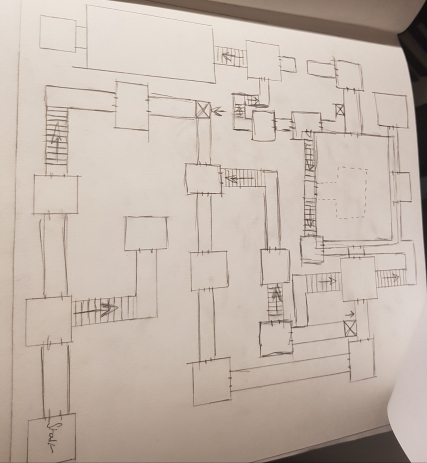
space in the game, reusing locations or allowing for multipath navigation where some elements I considered during the design process of creating the environment. I started by designing the game spaces that players could occupy and scale the level to player progression, this enabled me to ensure the level felt fluid. Next came the base layout for checkpoints and doors, locks and shortcuts, allowing players to return to previous areas without travelling back through the path they initially took, by creating a level that pulls the player to a soft left I created a map that would allow this as the map is always adjacent to the last section of level, players travel in an anti-clockwise fashion around the map to reach the end while being offered plenty of different paths and opportunity this brings forth a sense of familiarity.
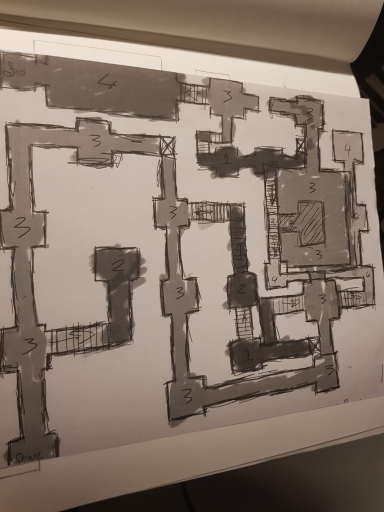
After the rough level design came the floors, (which floor would each section be on), the first iteration offered several layers for players to traverse and this evolved into the floors 1-5 in the final draft, these levels interconnect and offer variety to the player rather than simply adventuring across a plane.
During the first design phase, the game was going to be one single dungeon with puzzle rooms and riddles, the environmental design would be very a classic dungeon style and play on the dungeon crawling genera as a large aspect, I looked at different dungeons around the world and underground spaces to get an idea for theme of visual design and what sort of puzzles might exist in these spaces – Underground gardens and temples to burial sites and ice caves across the world and although these exotic locations would have been interesting to design with, I wanted a location that tied in with the narrative a little better and so I considered places that demons may dwell, dark places evil places and of course the thing that all demons have in common, the afterlife – and so I looked at representations of hell from different religions and mythologies. These gave some great ideas, I worked on the idea that the environments would vary the further you progress in the game to display different forms of hell, Having a Christian hell representation was an important element as so many religions and mythologies draw inspiration from this that using this as a basis for a level section would cover much of this, I also wanted a contrast from the flaming pits of hell that Christian hell details and so my first thought was Norse believe with their 9 worlds. The Norse representation of Hell (Helheim) is cold, icy and misty, very different to the former representation, unfortunately Helheim has been very poorly documented in comparison to Christian Hell due to Norse Vikings in the 800 AD people often not detailing their mythologies with visuals or writing and so much of the design would have to come from ideation rather than research.
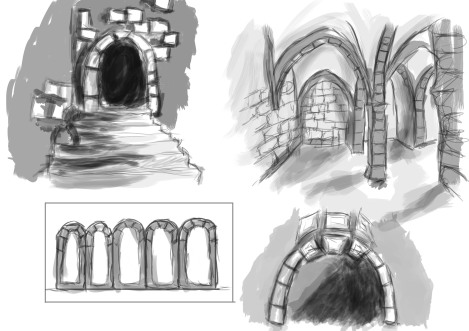
My other consideration was that perhaps there should be a foreshadowing or precursor to these sections – That is why I considered having an actual dungeon section to the game to act as a start point, to teach the players how to combat the challenges ahead and allow them to fully take in the environments later in the game, a huge reason for the environment looking the way it does is due to it taking the form of what the player thinks Hell might look like, section 1 being the gateway, two being the cold version and final being firery hell. I also considered a fourth space that would be akin to a void like design representing the atheist belief of nothing after death, however, I left that a fourth space would be unnecessary with the content I already had and so this idea was dropped there.
Now that my three spaces existed, I worked on some visualisations and how the level might work, I worked on transforming my environmental spaces into a level design, things that players could see and paths for them to travel, then came dividing them into

the three sections of level for individual designing in terms of concept art. Marking Lightrooms, levers, lifts, doors, stairs and boss rooms was a step taken after that and resulted in the final map of the environment.
Modelling the first room in the game – created in 3ds max. Skip to 10:30 for final result in unity
Art style and visuals
Although mostly explained within the art styles section in the ideation page – Visually, I wanted to create a very high-quality environment while keeping the polygon count low to enable more systems to run the game (another reason for the chosen art style) refer to the video above – This is an example of a low poly environment that can be game ready – In terms of 3D constraints, Utilising effective culling methods such as occlusion and backface culling as well as a possible render distance will enable the visuals to fully come to life. For the environmental colour pallets, I used original images from the research locations and broke these down into base colours, this then formed the basis for creating my environmental colour sets.
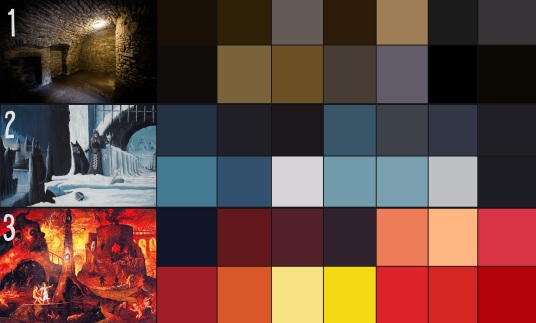
Mechanics
Mechanical systems became a fundamental focus of this game, creating a game where the mechanics and environment worked together in new and original ways was one of my personal goals. Starting initially with puzzles in the form of rooms was environmental based mechanics that
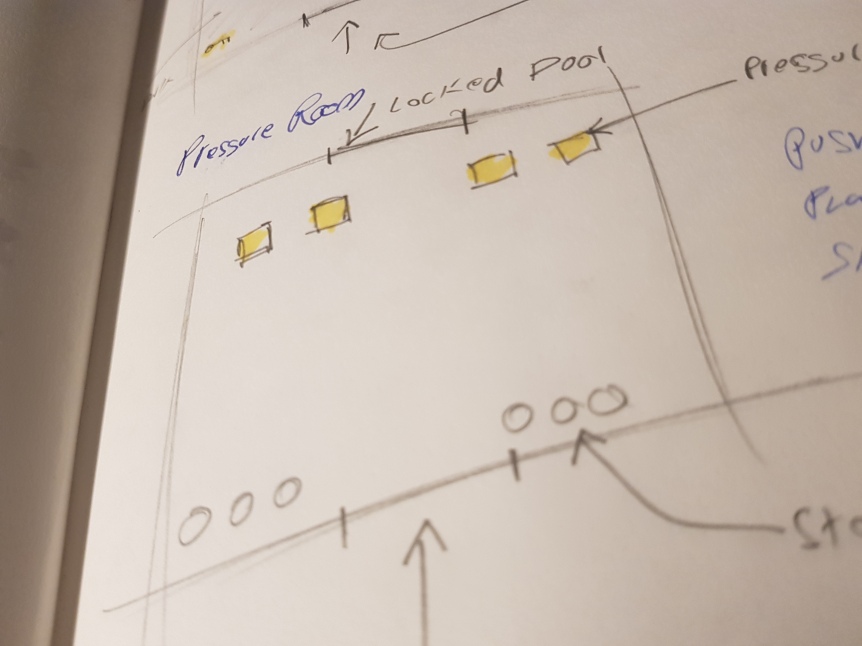
required players to problem solve to progress, I designed several variations of this, players would venture through the level combatti
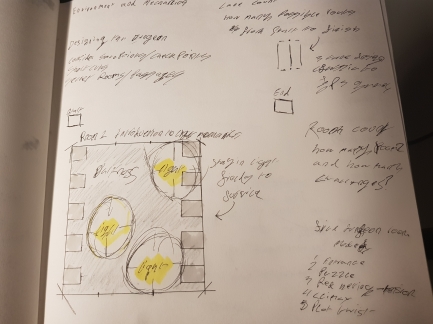
ng enemies and then upon reaching a puzzle room would attempt to solve the puzzle as a group, this was an initial solution to environmental based mechanics systems.
After some thought, some issues became evident with this system, these puzzles had little to no replay value, in other words, once the players understand the systems they cease to become a challenge and are simply an obstacle. There is also the consideration that the gameplay would feel a little disjointed, advancing from fast intensive combat to slow possibly tedious puzzle systems would possibly not add anything to the overarching experience and so I returned to the drawing board with how to create mechanical systems that did not hinder the experience but added to it.
Integrated features
Creating features that felt that they were created on a base level of the game, rather than surface elements that could fit in any dungeon crawler, essentially I wanted to change the way the genre is played, there is one simple way to do this and that was to take
systems that players believe they understand and make evident that these systems work differently – the systems I would change would be space and death as my primary elements. Starting with space, players understand that there is space in which they can venture into and space they cannot, this space is visible to they and so they believe that this space is accessible, this is where my light mechanic takes to the stage, players can venture into these spaces but only if the space is lit up, this is a constantly updating system as only one player can hold a torch, that one player alone decides the space that is accessible and this is a rule that dictates if players live or die, which brings me onto my next system, death.
Death can be handled in different ways and true the concept of punishment for failure is nothing new which is essentially this system however the way this is achieved is something new. Players lose their favourite item upon death as well as take a debuff on that class of weapons, a blow to the player in question and any of their teammates as well, why their favourite weapon and a debuff? This system does not allow players to forget their mistakes, the debuff will constantly remind them of this, however, an inherently cruel system is something that few enjoy and so the possibility of redemption at lightroom’s is always an option enabling players to buy their lost item back and negate the debuff in exchange for currency.
Another more abstract puzzle is the character class systems of Melee, Range and Mage, this is less an obstacle that players must overcome but more about adopting a strategy and making it work, players are free to choose whichever class they like and are not locked into using that weapon so there is still an element of freedom and allowing players to play the game as they choose but also giving them a helping hand at the beginning.
These systems are puzzles in their own way, they make the player think about the way they want to play rather than simply challenge them with generic puzzles and locked doors that can only be opened with riddles, these features look to the players to understand them and respect them, they present a challenge to the player but in a way that does not feel cheap, it’s not difficulty in for form of more enemies with more health, or the player being made to feel worthless by dealing no damage against impossible foes – the mechanics should keep players on their toes while always offering them a helping hand, should they need it.
